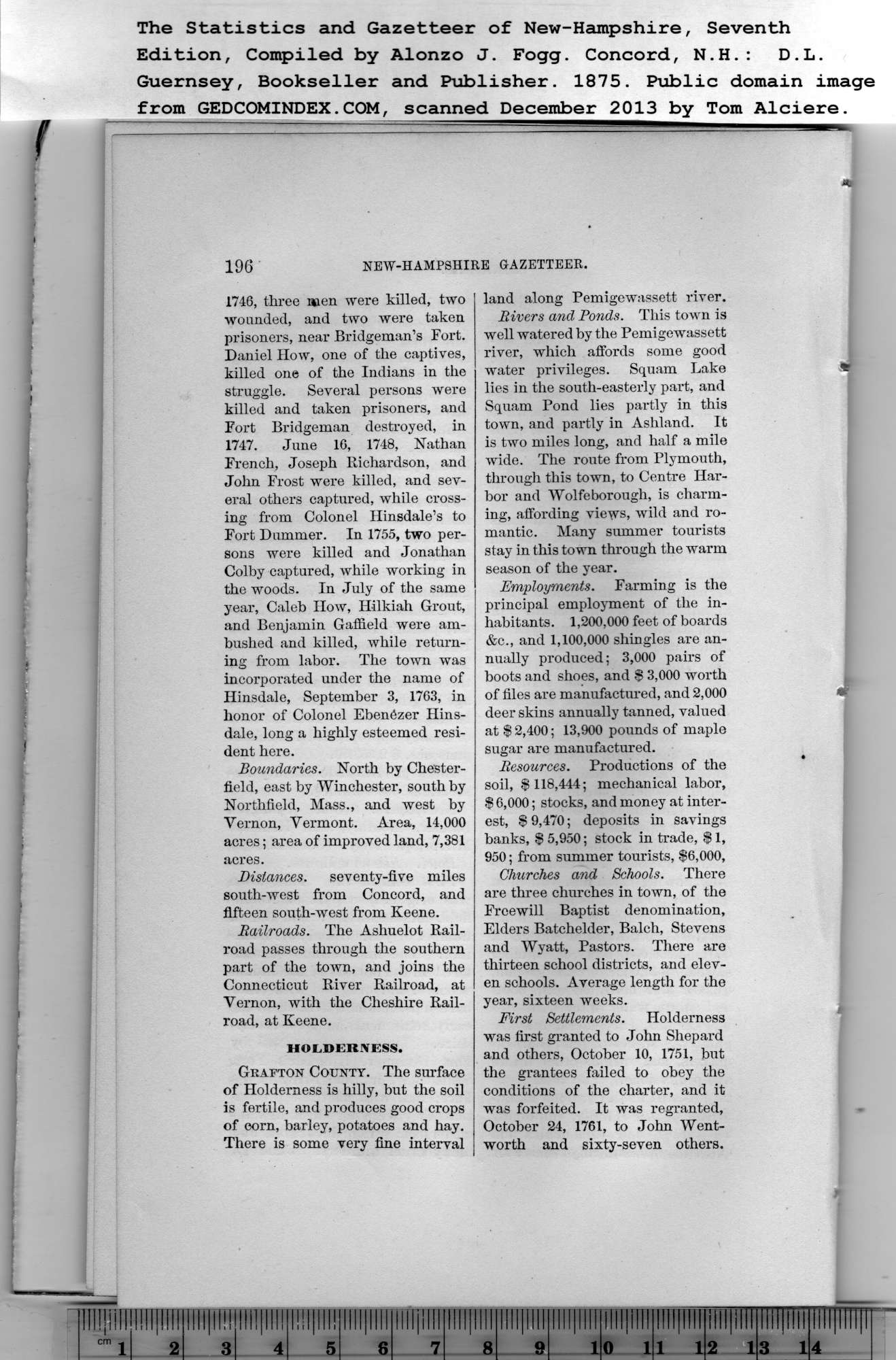|
1746, three men were killed, two
wounded, and two were taken
prisoners, near Bridgeman’s Fort.
Daniel How, one of the captives,
killed one of the Indians in the
struggle. Several persons were
killed and taken prisoners, and
Fort Bridgeman destroyed, in
1747. June 16, 1748, Nathan
French, Joseph Richardson, and
John Frost were killed, and sev-
eral others captured, while cross-
ing from Colonel Hinsdale’s to
Fort Dummer. In 1755, two per-
sons were killed and Jonathan
Colby captured, while working in
the woods. In July of the same
year, Caleb How, Hilkiah Grout,
and Benjamin Gaffield were am-
bushed and killed, while return-
ing from labor. The town was
incorporated under the name of
Hinsdale, September 3, 1763, in
honor of Colonel Eben£zer Hins-
dale, long a highly esteemed resi-
dent here.
Boundaries. North by Chester-
field, east by Winchester, south by
Northfield, Mass., and west by
Vernon, Vermont. Area, 14,000
acres; area of improved land, 7,381
acres.
Distances. seventy-five miles
south-west from Concord, and
fifteen south-west from Keene.
Railroads. The Ashuelot Rail-
road passes through the southern
part of the town, and joins the
Connecticut River Railroad, at
Vernon, with the Cheshire Rail-
road, at Keene.
HOLDERNESS.
Gkafton County. The surface
of Holderness is hilly, but the soil
is fertile, and produces good crops
of eorn, barley, potatoes and hay.
There is some very fine interval |
land along Pemigewassett river.
Rivers and Ponds. This town is
well watered by the Pemigewassett
river, which affords some good
water privileges. Squam Lake
lies in the south-easterly part, and
Squam Pond lies partly in this
town, and partly in Ashland. It
is two miles long, and half a mile
wide. The route from Plymouth,
through this town, to Centre Har-
bor and Wolfeborough, is charm-
ing, affording views, wild and ro-
mantic. Many summer tourists
stay in this town through the warm
season of the year.
Employments. Farming is the
principal employment of the in-
habitants. 1,200,000 feet of boards
&c., and 1,100,000 shingles are an-
nually produced; 3,000 pairs of
boots and shoes, and $ 3,000 worth
of files are manufactured, and 2,000
deer skins annually tanned, valued
at $2,400; 13,900 pounds of maple
sugar are manufactured.
Resources. Productions of the
soil, $118,444; mechanical labor,
$ 6,000; stocks, and money at inter-
est, $ 9,470; deposits in savings
banks, $ 5,950; stock in trade, $1,
950; from summer tourists, $6,000,
Churches and Schools. There
are three churches in town, of the
Freewill Baptist denomination,
Elders Batchelder, Balch, Stevens
and Wyatt, Pastors. There are
thirteen school districts, and elev-
en schools. Average length for the
year, sixteen weeks.
First Settlements. Holderness
was first granted to John Shepard
and others, October 10, 1751, but
the grantees failed to obey the
conditions of the charter, and it
was forfeited. It was regranted,
October 24, 1761, to John Went-
worth and sixty-seven others. |
